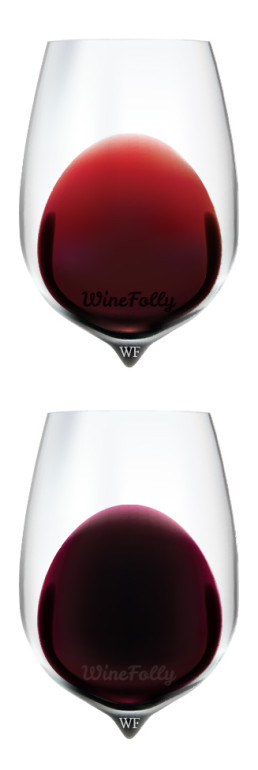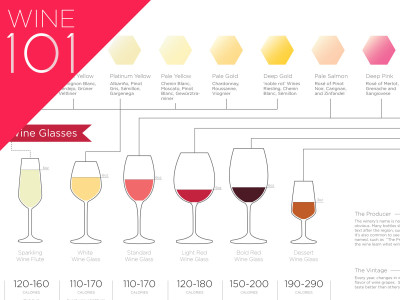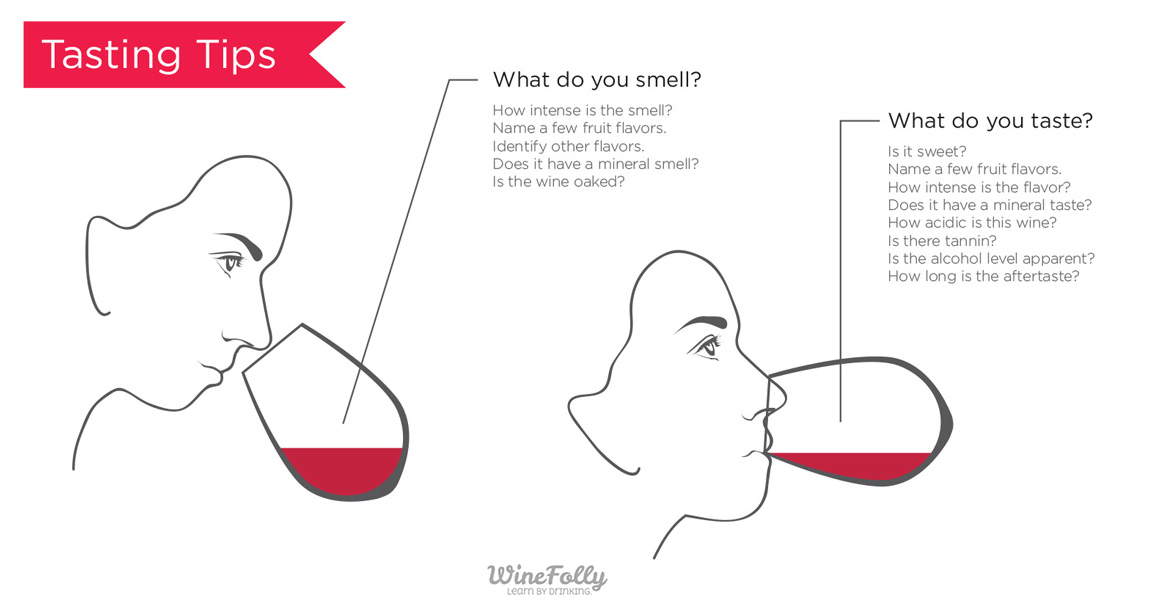This method contains the fundamental parts of all wine tasting techniques. In essence, there are about 4 things to do when you actively taste wine. You can apply this method to anything you eat or drink and you’ll find that it makes you incredibly more aware of what’s in your food. So, let’s get started!
Grab a full-bodied red wine and pour a little into a glass.
Why red wine? It’s better to learn how to taste with a red wine. This is because red wines have more obvious traits (such as tannin) that are easier to pick up on.
How do I taste all the nuances in wine?
Is your friend picking up ‘freshly wetted concrete’, ‘mulberries’, and ‘nuances of black panda candy’ in wine and you’re just feeling a wet warming sensation in your throat? While some of these wine descriptions are B.S. (and your friend should be slapped for rubbing them into your face), you might not be taking advantage of all the tools available to you. You might actually be an awesome taster and you just haven’t unlocked your skills.
Your tools are, of course, your senses:
- EYES what the color tells you about wine
- NOSE what smell tells you about wine
- TASTE how to pick out flavors in wine
- FEEL what is texture in wine?
With the 4 senses used correctly, you’ll be able to quickly assess a wine using the following 4 steps.
The Geek Technique on How to Taste Red Wine
1. What exactly are we assessing?
When you look at wine, it’s not just to verify the color. Look for things like density, viscosity, flocculation (aka bits of stuff floating around), and how intense it looks. This is your chance to size up your wine.

-
What density tells you:
Wines that have very little translucence and are rich in color are usually young and from warmer regions or highly-extracted (the winemakers really soaked the crap out of the skins to capture more color and/or tannin). A blue-tinged rim on some wines correlate with lower acidity whereas a red-tinged rim correlates with higher acidity (low pH). Color doesn’t just tell you acidity level though, if it’s a little orangish on the edges, it may be several years (or even decades) old. When you have a very translucent wine that’s weak in color it could be from a cooler region or from a light red wine.
-
What viscosity tells you:
Viscosity (aka ‘tears’ or ‘legs’) can tell you several things including alcohol level and sweetness in a wine. Since most red wines are dry, you can usually assume that a higher viscosity wine means that it’s higher in alcohol. A higher alcohol wine can only be made with super ripe grapes, which usually come from warmer growing regions (e.g. California, Australia, Spain etc.).
-
What suspended particles tell you:
If the wine is unfiltered it will have little bits of stuff in it. As a general rule, large productions shy away from this technique for fear of inconsistency. Also, Old World regions often have entrenched traditions of using old-school winemaking methods.
Color of wine is something that professionals look at pretty quickly. It’s like deciding what side of your burger to bite into first. You don’t need to spend too much time gazing into your wine glass unless you’re a fortune teller.

Instant Answers: The Basic Wine Guide
Check out a chart that covers a wealth of fundamental wine knowledge. Quickly reference flavors in wine, which wine glasses to use, how to serve wine, and tips to improve your tasting.
2. How to identify smells in wine
This is the most important part of wine tasting. Actually, this is the most important part of enjoying food. Sense of smell is so underused that if you practice a little, you’ll blow people away with your sudden chef-like badass skills.
Try the ‘Disassociation Method’
Most wine professionals I’ve talked to use some variation of what I like to call ‘The Disassociation Method’. Smell the wine (not too long that it burns) and then disassociate that aroma from what it smells like (i.e. a blackberry). A great trick is to pretend you’re not smelling wine and then identify what you are smelling. Perhaps it’s cherry syrup or perhaps it smells like that time when you walked into a parking lot after a summer rain. There are no wrong answers.
What exactly am I smelling?
Everything you smell in wine is from acids and alcohol: esters, aldehydes, ketones and acetals.
- Primary Aromas These aromas are from the grape variety or the blend. They will most likely be fruit and berry aromas, although some are very unique such as bell pepper (some Cabernet Franc), hot dog (some Carignan) and anise (some Barbera).
- Secondary Aromas These aromas come from winemaking, they will have something about them that’s yeasty. Here are a few examples: bread, cheese, beer-like, sourdough, sour cream, etc.
- Tertiary Aromas These aromas come from oak and/or aging of wines. A very classic and easy to pick out tertiary aroma is vanilla that comes from oak aging. This list also includes smells similar to nuts, spices, woods, toasted breads, leathery smells, smoked or burnt smells, and butter.
3. What am I tasting?

Besides the generalized flavor of ‘wine’ there’s actually a lot going on. Red wine contains alcohol, acids, tannin and sometimes sugar (if only in tiny amounts). All of these individual components can be identified with our mouths. I say mouths because we taste with more than just the tongue.
-
How to taste sweetness in wine
Sweetness is something you have to taste up front and right away. It hits you for a split second on the tip of your tongue. While plain sugar does hang on our tastebuds as a lingering oily-sour note, it’s hard to identify it after the initial burst. Many red wines have just a teensy touch of residual sugar (RS) to give wine more body. Ever heard of Apothic Red by Gallo? This wine tastes ‘dry’ but has 1.65 g/L of RS.
-
How to taste alcohol in wine
The sensation of alcohol is something you feel towards the back of your throat. With experience, you can identify alcohol level within a percentage.
-
How to taste tannin in wine
Tannin is both a textural component and bitter flavor in wine. High-tannin wines almost feel like having a wet tea bag on your tongue; they dry your mouth out. The way the tannin feels can tell you what kind of tannin it is. Grape tannins (which are from pips) tend to be more grippy and will stick the insides of your lips to your teeth. Oak tannins vary quite a bit (depending on the types of oak used) but most oak tannins hit the sides and center back of your tongue.
-
How to taste acidity in wine
Acidity is the tartness or the sourness of a wine. Acidity ranges in wine go from butter-like to lemony. Acidity is something that persists in your mouth after you’ve swallowed. High acidity will make your mouth water.
4. What conclusions can I make about this wine
With the methods used above you can quickly identify specifically what you like or hate about a wine. For instance, if you hate how some red wines taste light and have high acidity, then you can conclude that you might not enjoy a region such as Beaujolais, which is known for high acidity.
Make a note how the taste evolves over time in your mouth or even as you drink a glass.
Build Your Tastebud Repertoire
If you haven’t ever tasted a raw black currant (cassis) or bit into a gooseberry then you might try expanding your palate by tasting new fruits and vegetables. You never know what flavor you’ll find next in your glass.
Sources
Want to seriously geek out? Get Wine Tasting: A Professional Handbook
The Basic Wine Guide print


